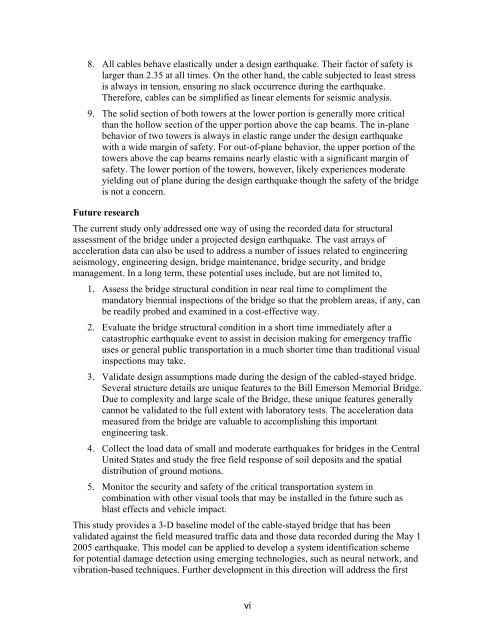Assessment of the Bill Emerson Memorial Bridge - FTP Directory ...
Assessment of the Bill Emerson Memorial Bridge - FTP Directory ...
Assessment of the Bill Emerson Memorial Bridge - FTP Directory ...
- No tags were found...
You also want an ePaper? Increase the reach of your titles
YUMPU automatically turns print PDFs into web optimized ePapers that Google loves.
8. All cables behave elastically under a design earthquake. Their factor <strong>of</strong> safety islarger than 2.35 at all times. On <strong>the</strong> o<strong>the</strong>r hand, <strong>the</strong> cable subjected to least stressis always in tension, ensuring no slack occurrence during <strong>the</strong> earthquake.Therefore, cables can be simplified as linear elements for seismic analysis.9. The solid section <strong>of</strong> both towers at <strong>the</strong> lower portion is generally more criticalthan <strong>the</strong> hollow section <strong>of</strong> <strong>the</strong> upper portion above <strong>the</strong> cap beams. The in-planebehavior <strong>of</strong> two towers is always in elastic range under <strong>the</strong> design earthquakewith a wide margin <strong>of</strong> safety. For out-<strong>of</strong>-plane behavior, <strong>the</strong> upper portion <strong>of</strong> <strong>the</strong>towers above <strong>the</strong> cap beams remains nearly elastic with a significant margin <strong>of</strong>safety. The lower portion <strong>of</strong> <strong>the</strong> towers, however, likely experiences moderateyielding out <strong>of</strong> plane during <strong>the</strong> design earthquake though <strong>the</strong> safety <strong>of</strong> <strong>the</strong> bridgeis not a concern.Future researchThe current study only addressed one way <strong>of</strong> using <strong>the</strong> recorded data for structuralassessment <strong>of</strong> <strong>the</strong> bridge under a projected design earthquake. The vast arrays <strong>of</strong>acceleration data can also be used to address a number <strong>of</strong> issues related to engineeringseismology, engineering design, bridge maintenance, bridge security, and bridgemanagement. In a long term, <strong>the</strong>se potential uses include, but are not limited to,1. Assess <strong>the</strong> bridge structural condition in near real time to compliment <strong>the</strong>mandatory biennial inspections <strong>of</strong> <strong>the</strong> bridge so that <strong>the</strong> problem areas, if any, canbe readily probed and examined in a cost-effective way.2. Evaluate <strong>the</strong> bridge structural condition in a short time immediately after acatastrophic earthquake event to assist in decision making for emergency trafficuses or general public transportation in a much shorter time than traditional visualinspections may take.3. Validate design assumptions made during <strong>the</strong> design <strong>of</strong> <strong>the</strong> cabled-stayed bridge.Several structure details are unique features to <strong>the</strong> <strong>Bill</strong> <strong>Emerson</strong> <strong>Memorial</strong> <strong>Bridge</strong>.Due to complexity and large scale <strong>of</strong> <strong>the</strong> <strong>Bridge</strong>, <strong>the</strong>se unique features generallycannot be validated to <strong>the</strong> full extent with laboratory tests. The acceleration datameasured from <strong>the</strong> bridge are valuable to accomplishing this importantengineering task.4. Collect <strong>the</strong> load data <strong>of</strong> small and moderate earthquakes for bridges in <strong>the</strong> CentralUnited States and study <strong>the</strong> free field response <strong>of</strong> soil deposits and <strong>the</strong> spatialdistribution <strong>of</strong> ground motions.5. Monitor <strong>the</strong> security and safety <strong>of</strong> <strong>the</strong> critical transportation system incombination with o<strong>the</strong>r visual tools that may be installed in <strong>the</strong> future such asblast effects and vehicle impact.This study provides a 3-D baseline model <strong>of</strong> <strong>the</strong> cable-stayed bridge that has beenvalidated against <strong>the</strong> field measured traffic data and those data recorded during <strong>the</strong> May 12005 earthquake. This model can be applied to develop a system identification schemefor potential damage detection using emerging technologies, such as neural network, andvibration-based techniques. Fur<strong>the</strong>r development in this direction will address <strong>the</strong> firstvi
















